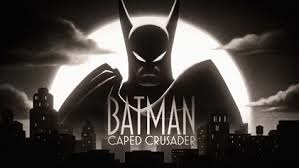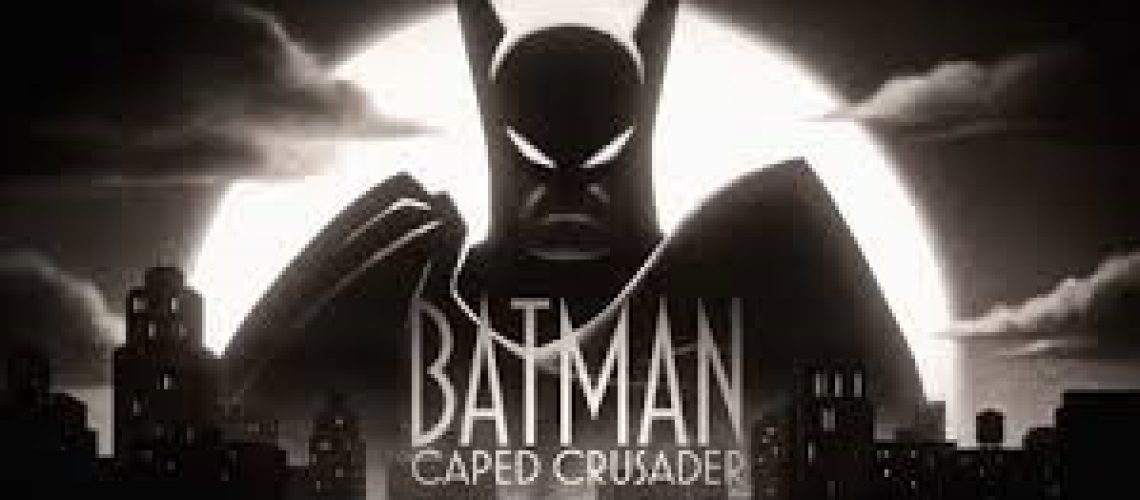I got around to watching Batman: Caped Crusader, Season 1, during the last couple of weeks, after some people whose judgment I respect recommended it. Amazon Prime Video dropped all 10 half-hourish episodes on Aug. 1. It’s not essential viewing, but I found it refreshingly entertaining and intriguing, although it does go dark at times.

First of all, I love the aesthetics of this series. Here, Gotham City is very noir, dark both morally and, in a lot of cases, literally, but not so much so that you can’t pick out the lovely art deco details on a lot of the buildings and furnishings. Ladies’ clothes and hats seem firmly seated in the 1930s and ’40s (and I love some of those hats!); I don’t know as much about men’s clothes, but they seem fine too. Cars on the street also seemed to have the right look – I’m not a car aficionado, either, but I’ve watched plenty of old movies set back then, and everything seemed to fit.
Secondly, I love that despite embracing that era’s look, the series basically jettisons the racism, sexism, and several other -isms of the times. Commissioner Jim Gordon, his public-defender daughter Barbara, and Police Detective Arnold Flass, Harvey Bullock’s partner, are all black, and nobody ever mentions their race. Detective Renee Montoya has a dinner date with Dr. Harleen Quinzel, and nobody in the restaurant bats an eye at this lesbian pairing. A sometimes major villain is gender-flipped. Montoya, Bullock, and several other characters are hefty, and it doesn’t affect any of their job performances (except Bullock gets tired out running after someone), and nobody ever makes a fat joke. Quinzel is never treated and with disrespect; Bullock complains when Montoya is picked to lead a task force, but it seems that’s because she’s too good at her job; and although District Attorney Harvey Dent tries to crush Barbara Gordon in court, that seems to be about his desire to win at all costs, rather than her gender.
Thirdly, I love the character arcs. Dent is almost as complicated a character as Batman (I’ll get to him soon). He seems to genuinely believe that the mayor and police are corrupt and he’s the right man to clean up Gotham, but he doesn’t seem to care about individuals – most blatantly, when he ignores reports of kids going missing at a carnival, when those orphans were there as props at a press event for his mayoral campaign. He’s too busy worrying about the moral dilemma he’s caught in, having decided to take dirty money from a mob boss after he started sliding in the polls (due to his lack of human-interaction skills). Like every watcher who knows much at all about Batman lore, I was wondering when Dent’s two-faced nature would rise to the foreground; I had bet on the last episode, but it happened sooner, with the last pair of episodes following the consequences from his gradual heel-turn through to a conflicted, dramatic face-turn.
So, Dent’s character has a definite arc. So does Batman, although it takes until the last episode for him to show much humanity; for most of these 10 episodes, he is an outright jerk on a revenge quest, much more interested in catching crooks than helping people. His Bruce Wayne facade is nothing more than camouflage for the vigilante. He drags his “friend” Dent out to dinner after Harvey’s great tragedy; ostensibly, it’s to cheer him up, but Wayne keeps pushing Dent to remember what happened, and it’s obvious that he’s just trying to catch a perpetrator. Batman knocks beat cops unconscious just for being in his way – although many cops here *are* corrupt, it’s not like he checks their backstories. He leaves one criminal to die in a fire while he pursues another fugitive; later, he saves those kids at the carnival and other kids in a tenement fire, but most of the time that he saves an adult, it’s the byproduct of stopping a criminal. Finally, he is brutally dismissive of his assistant, the butler who raised him from childhood, not just like “stop nagging me to get some sleep” but more like in a “know your place, servant” way; only at the end of the last episode does he call Pennyworth by his first name, Alfred.
Could Bruce be doing a lot more good for the people of Gotham by using his Wayne millions thoughtfully than by dressing up in a bat costume and punching people? Almost certainly. Does this series show that Batman needs some mental health help? I’d say so; Bruce Wayne lies his way through court-ordered therapy with Quinzel early in the show, denying that seeing his parents murdered as a boy had any lingering effects; but Batman comes to recognize parallels between Dent’s fall and where he himself could be going with his own obsessions; by the end, he has made some alliances, and acknowledges a sort of friendship with Alfred.
Fourthly, I love all the rich flavorings of this series. In Caped Crusader, we meet a lot of characters who get a lot of room to breathe, seeing developments such as Jim Gordon’s bureaucratic struggles with an impatient mayor who wants this “Batman” caught, while bad cops take advantage of events to win good press and block his reform efforts; Lucius Fox pursuing his own low-income housing development deals while handling Wayne’s finances; and Boss Thorne watching baseball with his son. There are even a couple of surprising supernatural/weird horror plotlines, but most of Batman’s adversaries feel real and grounded. I am very happy that there’s no whiff of Batman’s frequent nemesis, the Joker, in this first season, until a stinger-hint at the very end. Too often, the Joker sucks all the oxygen out of a series or movie.
Finally, I really enjoyed all the Easter eggs, references and foreshadowings throughout this show. I grew up more of a Marvel girl than a DC fan, but my daddy had a giant hardback book that collected decades of Batman comics, from the 1930s through the 1970s, so I saw Batman’s evolving styles and moods there; I loved the campy 1960s TV show; I watched most of the movies between Batman (1966) and The Dark Knight (2008), and I thought the Gotham series (2014-2019) did some fascinating things. So I’ve seen a lot of the characters who showed up in Caped Crusader; when they did what I expected, I enjoyed seeing how the show executed its take on them; where they surprised me, I was delighted.
Batman: Caped Crusader had a really good first season. I do think the name is a little weird, given that “Caped Crusader” usually evokes more of a bright, heroic tone than the noir mood of this show; however, recalling how the real-life Crusaders sacked Constantinople, then the world’s largest Christian city, and committed many other atrocities, perhaps it’s not such a bad title for this rage-filled, obsessive Batman. Hopefully, next season he can find a few happy moments and steer a few points away from revenge and toward actually helping the people of his city.
Content warnings: Violence, murders (mostly just off camera, or people falling down from gunshots, not much gore), child endangerment/non-permanent harm, deliberate disfigurement, police corruption.







